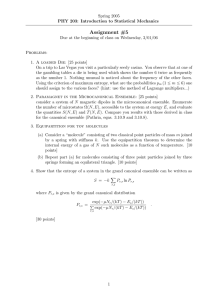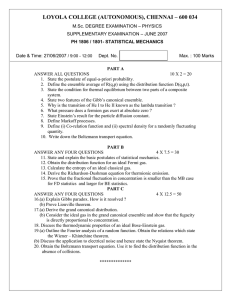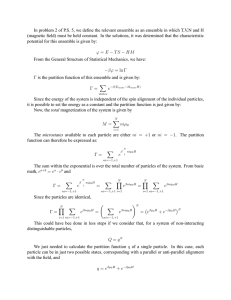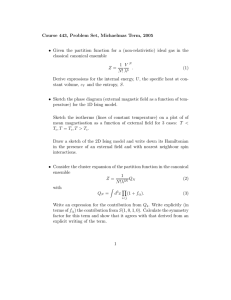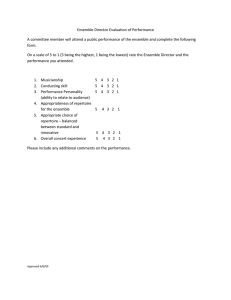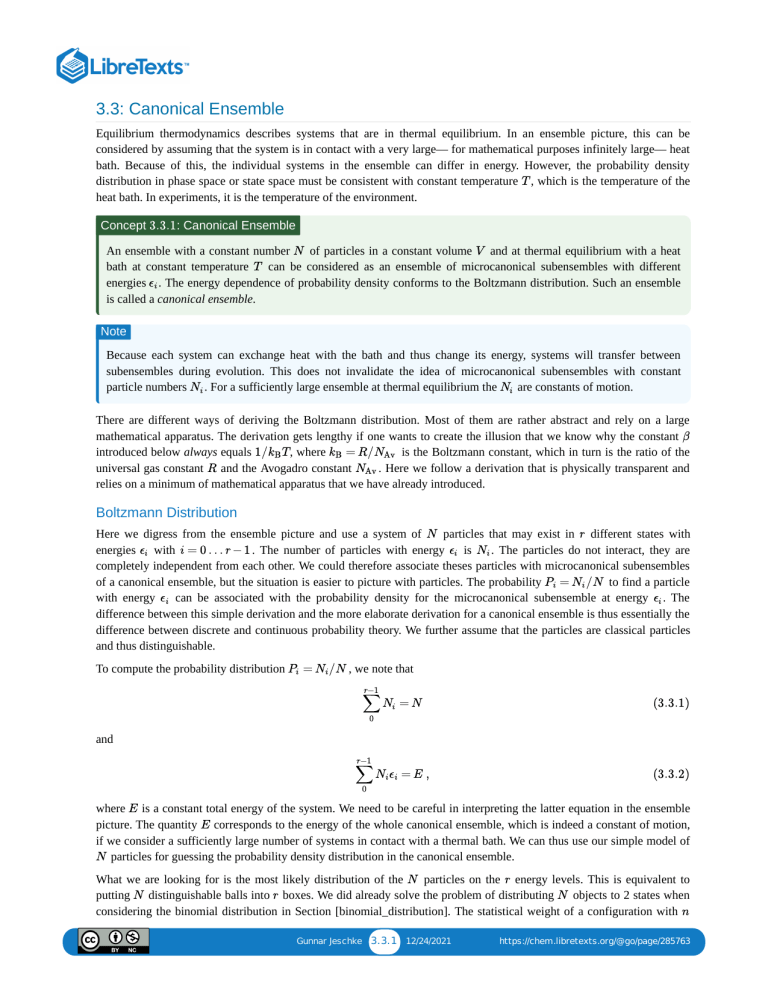
3.3: Canonical Ensemble
Equilibrium thermodynamics describes systems that are in thermal equilibrium. In an ensemble picture, this can be
considered by assuming that the system is in contact with a very large— for mathematical purposes infinitely large— heat
bath. Because of this, the individual systems in the ensemble can differ in energy. However, the probability density
distribution in phase space or state space must be consistent with constant temperature T , which is the temperature of the
heat bath. In experiments, it is the temperature of the environment.
Concept 3.3.1: Canonical Ensemble
An ensemble with a constant number N of particles in a constant volume V and at thermal equilibrium with a heat
bath at constant temperature T can be considered as an ensemble of microcanonical subensembles with different
energies ϵ . The energy dependence of probability density conforms to the Boltzmann distribution. Such an ensemble
is called a canonical ensemble.
i
Note
Because each system can exchange heat with the bath and thus change its energy, systems will transfer between
subensembles during evolution. This does not invalidate the idea of microcanonical subensembles with constant
particle numbers N . For a sufficiently large ensemble at thermal equilibrium the N are constants of motion.
i
i
There are different ways of deriving the Boltzmann distribution. Most of them are rather abstract and rely on a large
mathematical apparatus. The derivation gets lengthy if one wants to create the illusion that we know why the constant β
introduced below always equals 1/k T , where k = R/N is the Boltzmann constant, which in turn is the ratio of the
universal gas constant R and the Avogadro constant N . Here we follow a derivation that is physically transparent and
relies on a minimum of mathematical apparatus that we have already introduced.
B
B
Av
Av
Boltzmann Distribution
Here we digress from the ensemble picture and use a system of N particles that may exist in r different states with
energies ϵ with i = 0 … r − 1 . The number of particles with energy ϵ is N . The particles do not interact, they are
completely independent from each other. We could therefore associate theses particles with microcanonical subensembles
of a canonical ensemble, but the situation is easier to picture with particles. The probability P = N /N to find a particle
with energy ϵ can be associated with the probability density for the microcanonical subensemble at energy ϵ . The
difference between this simple derivation and the more elaborate derivation for a canonical ensemble is thus essentially the
difference between discrete and continuous probability theory. We further assume that the particles are classical particles
and thus distinguishable.
i
i
i
i
i
i
i
To compute the probability distribution P
i
= Ni /N
, we note that
r−1
∑ Ni = N
(3.3.1)
0
and
r−1
∑ Ni ϵi = E ,
(3.3.2)
0
where E is a constant total energy of the system. We need to be careful in interpreting the latter equation in the ensemble
picture. The quantity E corresponds to the energy of the whole canonical ensemble, which is indeed a constant of motion,
if we consider a sufficiently large number of systems in contact with a thermal bath. We can thus use our simple model of
N particles for guessing the probability density distribution in the canonical ensemble.
What we are looking for is the most likely distribution of the N particles on the r energy levels. This is equivalent to
putting N distinguishable balls into r boxes. We did already solve the problem of distributing N objects to 2 states when
considering the binomial distribution in Section [binomial_distribution]. The statistical weight of a configuration with n
Gunnar Jeschke 3.3.1 12/24/2021
https://chem.libretexts.org/@go/page/285763
objects in the first state and N − n objects in the second state was ( ). With this information we would already be able to
solve the problem of a canonical ensemble of N spins S = 1/2 in thermal contact with the environment, disregarding for
the moment differences between classical and quantum statistics (see Section [section:quantum_statistics]).
N
n
Coming back to N particles and r energy levels, we still have N ! permutations. If we assign the first N particles to the
state with energy ϵ , the next N particles to ϵ and so on, we need to divide each time by the number of permutations N !
in the same energy state, because the sequence of particles with the same energy does not matter. We call the vector of the
occupation numbers N a configuration. The configuration specifies one particular macrostate of the system and the
relative probability of the macrostates for distinguishable particles and non-degenerate states is given by their statistical
weights,
0
0
1
1
i
i
N!
Ω =
.
(3.3.3)
N0 ! N1 ! … Nr−1 !
The case with degenerate energy levels is treated in Section [sec:Maxwell-Boltzmann].
The most probable macrostate is the one with maximum statistical weight Ω. Because of the peaking of probability
distributions for large N , we need to compute only this most probable macrostate; it is representative for the whole
ensemble. Instead of maximizing Ω we can as well maximize ln Ω , as the natural logarithm is a strictly monotonous
function. This allows us to apply Stirling’s formula,
r−1
ln Ω = ln N ! − ∑ ln Ni !
(3.3.4)
i=0
r−1
r−1
≈ N ln N − N + 1 − ∑ Ni ln Ni + ∑ Ni − r .
i=0
(3.3.5)
0
By inserting Equation 3.3.1 we find
r−1
ln Ω ≈ N ln N − ∑ Ni ln Ni + 1 − r .
(3.3.6)
i=0
Note that the second term on the right-hand side of Equation
suggests that ln Ω is related to entropy.
3.3.6
has some similarity to the entropy of mixing, which
At the maximum of ln Ω the derivative of ln Ω with respect to the N must vanish,
i
0 = δ ∑ Ni ln Ni = ∑ (Ni δ ln Ni + δNi ln Ni ) = ∑ δNi + ∑ ln Ni δNi .
i
i
i
(3.3.7)
i
In addition, we need to consider the boundary conditions of constant particle number, Equation 3.3.1,
δN = ∑ δNi = 0
(3.3.8)
i
and constant total energy, Equation 3.3.2,
δE = ∑ ϵi δNi = 0 .
(3.3.9)
i
It might appear that Equation 3.3.8 could be used to cancel a term in Equation 3.3.7, but this would be wrong as Equation
3.3.8 is a constraint that must be fulfilled separately. For the constrained maximization we can use the method of Lagrange
multipliers.
The maximum or minimum of a function f (x
1
… , xn )
of n variables is a stationary point that is attained at
n
∂f
δf = ∑ (
i=1
)
∂xi
∂ xi = 0 .
(3.3.10)
xk ≠xi
We now consider the case where the possible sets of the n variables are constrained by c additional equations
gj (x1 , x2 , … , xn ) = 0 ,
(3.3.11)
Gunnar Jeschke 3.3.2 12/24/2021
https://chem.libretexts.org/@go/page/285763
where index j runs over the c constraints (j = 1 … c ). Each constraint introduces another equation of the same form as the
one of Equation 3.3.10,
n
∂gj
δgj = ∑ (
)
∂xi
i=1
The constraints can be introduced by multiplying each of the
equation for the stationary point without the constraints,
n
i=1
If a set of variables
)
∂xi
(3.3.12)
equations by a multiplier
c
c
∂f
δL = ∑ [ (
∂ xi = 0 .
xk ≠xi
and subtracting it from the
∂gj
− ∑ λj (
xk ≠xi
λj
j=1
)
∂xi
] ∂ xi .
(3.3.13)
xk ≠xi
solves the constrained problem then there exists a set {λ … λ } for which
also corresponds to a stationary point of the Lagrangian function L(x , … , x , λ , … λ ). Note
that not all stationary points of the Lagrangian function are necessarily solutions of the constrained problem. This needs to
be checked separately. [concept:Lagrangian_multipliers]
{ x0,1 … , x0,n }
0,1
{ x0,1 , x0,2 , … , x0,n }
1
0,r
n
1
r
With this method, we can write
0
= ∑ δNi + ∑ ln Ni δNi + α ∑ δNi + β ∑ ϵi δNi
i
i
i
(3.3.14)
i
= ∑ δNi (1 + ln Ni + α + β ϵi ) .
(3.3.15)
i
The two boundary conditions fix only two of the population numbers N . We can choose the multipliers α and β in a way
that (1 + ln N + α + β ϵ ) = 0 for these two N , which ensures that the partial derivatives of ln Ω with respect to these
two N vanishes. The other r − 2 population numbers can, in principle, be chosen freely, but again we must have
i
i
i
i
i
1 + ln Ni + α + β ϵi = 0
(3.3.16)
for all i to make sure that we find a maximum with respect to variation of any of the r population numbers. This gives
Ni = γ e
with γ = e
−(1+α)
−βϵi
(3.3.17)
. We can eliminate γ by using Equation 3.3.1,
∑ Ni = γ ∑ e
i
−βϵi
=N ,
(3.3.18)
i
giving
N
γ =
,
(3.3.19)
∑ e−βϵi
i
and finally leading to
Pi =
Ni
e
−βϵi
=
N
.
∑i e
(3.3.20)
−βϵi
For many problems in statistical thermodynamics, the Lagrange multiplier α is related to the chemical potential by
α = μ/(k T ) . The Lagrange multiplier β must have the reciprocal dimension of an energy, as the exponent must be
dimensionless. As indicated above, we cannot at this stage prove that β is the same energy for all problems of the type that
we have posed here, let alone for all of the analogous problems of canonical ensembles. The whole formalism can be
connected to phenomenological thermodynamics via Maxwell’s kinetic gas theory (see also Section
[subsection:equipartition]). For this problem one finds
B
1
β =
.
(3.3.21)
kB T
Gunnar Jeschke 3.3.3 12/24/2021
https://chem.libretexts.org/@go/page/285763
Concept 3.3.2: Boltzmann Distribution
For a classical canonical ensemble with energy levels ϵ the probability distribution for the level populations is given
by the Boltzmann distribution
i
Pi =
Ni
e
−ϵi / kB T
=
N
.
∑i e
(3.3.22)
−ϵi / kB T
The sum over states
Z(N , V , T ) = ∑ e
−ϵi / kB T
(3.3.23)
i
required for normalization is called canonical partition function.10 The partition function is a thermodynamical state
function.
For the partition function, we use the symbol Z relating to the German term Zustandssumme("sum over states"), which is a
more lucid description of this quantity.
Equipartition Theorem
Comparison of Maxwell’s kinetic theory of gases with the state equation of the ideal gas from phenomenological
thermodynamics provides a mean kinetic energy of a point particle of ⟨ϵ ⟩ = 3k T /2 . This energy corresponds to
kin
1
ϵtrans =
2
mv
1
2
=
p
2
B
,
(3.3.24)
2m
i.e., it is quadratic in the velocity coordinates of dynamic space or the momentum coordinates of phase space. Translational
energy is distributed via three degrees of freedom, as the velocities or momenta have components along three pairwise
orthogonal directions in space. Each quadratic degree of freedom thus contributes a mean energy of k T /2.
B
If we accept that the Lagrange multiplier β assumes a value 1/k T , we find a mean energy k T of an harmonic oscillator
in the high-temperature limit . Such an oscillator has two degrees of freedom that contribute quadratically in the degrees of
freedom to energy,
B
1
ϵvib =
2
μv
B
1
+
2
2
fx
,
(3.3.25)
2
where μ is the reduced mass and f the force constant. The first term contributes to kinetic energy, the second to potential
energy. In the time average, each term contributes the same energy and assuming ergodicity this means that each of the two
degrees of freedom contributes with k T /2 to the average energy of a system at thermal equilibrium.
B
The same exercise can be performed for rotational degrees of freedom with energy
1
ϵrot =
2
Iω
,
(3.3.26)
2
where I is angular momentum and ω angular frequency. Each rotational degree of freedom, being quadratic in
contributes a mean energy of k T /2.
ω
again
B
Based on Equation 3.3.20 it can be shown that for an energy
f
ϵi = η0 + η1 + η2 + … = ∑ ηk ,
(3.3.27)
k=1
where index k runs over the individual degrees of freedom, the number of molecules that contribute energy
depend on the terms η with j ≠ k . It can be further shown that
ηk
does not
j
1
⟨ηk ⟩ =
(3.3.28)
2β
for all terms that contribute quadratically to energy.11
Gunnar Jeschke 3.3.4 12/24/2021
https://chem.libretexts.org/@go/page/285763
This result has two consequences. First, we can generalize β = 1/k T , which we strictly knew only for translational
degrees of freedom, to any canonical ensemble for which all individual energy contributions are quadratic along one
dimension in phase space. Second, we can formulate the
B
Each degree of freedom, whose energy scales quadratically with one of the coordinates of state space, contributes a mean
energy of k T /2.
B
The equipartition theorem applies to all degrees of freedom that are activated. Translational degrees of freedom are always
activated and rotational degrees of freedom are activated at ambient temperature, which corresponds to the hightemperature limit of rotational dynamics. To vibrational degrees of freedom the equipartition theorem applies only in the
high-temperature limit. In general, the equipartition theorem fails for quantized degrees of freedom if the quantum energy
spacing is comparable to k T /2 or exceeds this value. We shall come back to this point when discussing the vibrational
partition function.
B
Internal Energy and Heat Capacity of the Canonical Ensemble
The internal energy u of a system consisting of N particles that are distributed to r energy levels can be identified as the
total energy E of the system considered in Section ([subsection:Boltzmann]). Using Eqs. 3.3.2 and 3.3.22 we find
∑ ϵi e
−ϵi / kB T
∑ ϵi e
i
u =N
∑i e
−ϵi / kB T
i
=N
.
−ϵi / kB T
(3.3.29)
Z
The sum in the numerator can be expressed by the partition function, since
dZ
1
=
dT
∑ ϵi e
2
kB T
−ϵi / kB T
.
(3.3.30)
i
Thus we obtain
u = N kB T
2
1
⋅
dZ
⋅
Z
dT
= N kB T
2
d ln Z
.
(3.3.31)
dT
Again the analogy of our simple system to the canonical ensemble holds. At this point we have computed one of the state
functions of phenomenological thermodynamics from the set of energy levels. The derivation of the Boltzmann
distribution has also indicated that ln Ω , and thus the partition function Z are probably related to entropy. We shall see in
Section [section:state_fct_partition_fct] that this is indeed the case and that we can compute all thermodynamic state
functions from Z .
Here we can still derive the heat capacity c at constant volume, which is the partial derivative of internal energy with
respect to temperature. To that end we note that the partition function for the canonical ensemble relates to constant
volume and constant number of particles.
V
∂u
cV
=(
∂
)
∂T
=N
∂T
V
( kB T
2
∂ ln Z
∂T
∂ [∂ ln Z/∂1/T ]
= −N kB (
=
kB
T
2
∂
(
)
∂T
2
∂
)
V
=
= −N
∂T
V
N kB
T
2
∂ ln Z
( kB
)
∂1/T
(3.3.32)
V
∂ [∂ ln Z/∂1/T ]
(
)
∂1/T
(3.3.33)
V
ln z
2
∂(1/T )
)
.
(3.3.34)
V
In the last line of Equation 3.3.34 we have substituted the molecular partition function Z by the partition function for the
whole system, ln z = N ln Z . Note that this implies a generalization. Before, we were considering a system of N identical
particles. Now we implicitly assume that Equation 3.3.34, as well as u = k T
will hold for any system, as long as
we correctly derive the system partition function z .
2 d ln z
B
dT
We note here that the canonical ensemble describes a closed system that can exchange heat with its environment, but by
definition it cannot exchange work, because its volume V is constant. This does not present a problem, since the state
functions can be computed at different V . In particular, pressure p can be computed from the partition function as well (see
Section [section:state_fct_partition_fct]). However, because the canonical ensemble is closed, it cannot easily be applied to
Gunnar Jeschke 3.3.5 12/24/2021
https://chem.libretexts.org/@go/page/285763
all problems that involve chemical reactions. For this we need to remove the restriction of a constant number of particles in
the systems that make up the ensemble.
Gunnar Jeschke 3.3.6 12/24/2021
https://chem.libretexts.org/@go/page/285763
